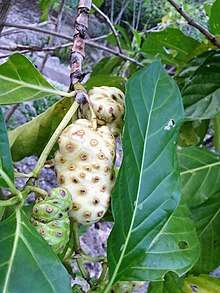Morinda
Morinda is a genus of flowering plants in the madder family, Rubiaceae.[1] The generic name is derived from the Latin words morus "mulberry", from the appearance of the fruits, and indica, meaning "of India".[2]
| Morinda | |
|---|---|
| Morinda citrifolia | |
 | |
| Morinda yucatanensis | |
| Scientific classification | |
| Kingdom: | Plantae |
| Clade: | Tracheophytes |
| Clade: | Angiosperms |
| Clade: | Eudicots |
| Clade: | Asterids |
| Order: | Gentianales |
| Family: | Rubiaceae |
| Subfamily: | Rubioideae |
| Tribe: | Morindeae |
| Genus: | Morinda L.[1] |
| Species | |
|
See text | |
| Synonyms | |
|
Belicia Lundell | |
Description
Distributed in all tropical regions of the world, Morinda includes 80 species of trees, shrubs or vines. All Morinda species bear aggregate or multiple fruits that can be fleshy (like Morinda citrifolia) or dry.[3] Most species of this genus originate in the area of Borneo, New Guinea, Northern Australia and New Caledonia.
In traditional Japanese, Korean and Chinese medicine, Morinda citrifolia is considered to be a herb with biological properties, although there is no confirmed evidence of clinical efficacy.[4]
Fossil record
The first fossil record for genus Morinda is from fruit of Morinda chinensis found in coal dated from the Eocene 56 to 33.9 million years ago in the Changchang Basin of Hainan Island, South China.[5]
Selected species
|
|
Plants in the former genus Appunettia are now considered synonymous with Morinda.
Formerly placed here
- Psychotria muscosa (Jacq.) Steyerm. (as Morinda muscosa Jacq.)[7]
References
| Wikimedia Commons has media related to Morinda. |
| Wikispecies has information related to Morinda |
- "Genus: Morinda L." Germplasm Resources Information Network. United States Department of Agriculture. 1996-09-17. Retrieved 2010-11-28.
- Quattrocchi, Umberto (2000). CRC World Dictionary of Plant Names. III: M-Q. CRC Press. p. 1730. ISBN 978-0-8493-2677-6.
- Sambamurty, A.V.S.S. (2005). Taxonomy of Angiosperms. I. K. International Pvt Ltd. p. 404. ISBN 978-81-88237-16-6.
- Potterat O, Hamburger M. (2007). "Morinda citrifolia (Noni) fruit--phytochemistry, pharmacology, safety". Planta Med. 73 (3): 191–9. doi:10.1055/s-2007-967115. PMID 17286240.
- Xianggang Shi, Jianhua Jin, Chuangxing Ye, Weiqiu Liu (2012). "First fruit fossil record of Morinda (Rubiaceae) from China". Review of Palaeobotany and Palynology. 179 (1 July): 13–16. doi:10.1016/j.revpalbo.2012.04.001.CS1 maint: uses authors parameter (link)
- "Morinda". Integrated Taxonomic Information System. Retrieved 2010-11-28.
- "GRIN Species Records of Morinda". Germplasm Resources Information Network. United States Department of Agriculture. Archived from the original on 2012-12-12. Retrieved 2010-11-28.